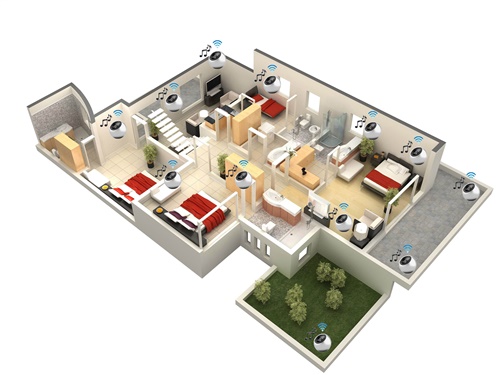SSZTBW8 November 2015
As more and more people embrace the Internet of Things (IoT), audio will continue to be an area of interest for developers and consumers alike. Streaming music has gained widespread popularity over the past few years, in large part because consumers now have multiple connected devices throughout their home at their disposal.
While wireless audio isn’t a new concept, the design of a multi-room audio solution can come with several new design challenges. Wi-Fi® synchronization is a key factor when creating a wireless audio solution, as discussed in our previous blog post. The primary challenge with multi-room audio systems is how to wirelessly distribute the audio amongst speakers that may be either at the very edge of coverage of the home access-point, or totally outside of it.
Typically, when a set of wireless speakers are in the same room and playback starts - one of the speakers in the room will be responsible for distributing the content to other speakers and synchronizing them (it might also need to actively download the content at the same time from an online music streaming service or get the content from a mobile device). The speaker would initiate a unicast stream with each of the speakers in the room, sending the appropriate audio data relevant to that speaker. While this audio stream (on the IP layer), is unicast – on the link layer (MAC) – all data must traverse through the home access-point and “bounce” to the speaker in the room. Each audio frame is therefore transmitted twice, potentially loading and congesting the wireless network.
This issue can be solved by using the “master” speaker as a soft AP (wireless access-point) while the rest of the speakers act as Wi-Fi station devices. At the same time - the “master” speaker acts as a Wi-Fi station device, to connect to the home network and pull content from the internet).
This can be achieved by using the WiLink™ 8 module’s multi-role capabilities.

While the range of Wi-Fi enabled audio devices is long - in some deployments and environments, due to structural factors, some rooms might either be with poor Wi-Fi coverage or without coverage at all. Wireless audio devices with poor coverage usually communicate with the home access point at low data rates (since those are more robust and have longer range than high data rates). When the data rate is lower, the wireless medium is busy (preventing other stations from transmitting at the same time) – which lowers overall network performance. Therefore, even if the home network infrastructure is based on high performance 802.11 devices (such as 802.11ac, for example) – the overall network performance will degrade in case some devices have poor coverage.
Some wireless audio devices may reside in rooms which have no Wi-Fi coverage at all. Traditionally, in such cases, it was required to either install more access-points around the house (acting as repeaters) or to connect the speakers inside those rooms with Ethernet cables.
Advanced 802.11 features, such as mesh networking, are able to meet the demands of both scenarios by extending the coverage of the home network and offload audio distribution. This is a feature that we’re adding to WiLink 8 to provide an even more robust solution.
While we discussed several of the challenges of multi-room audio here, TI has made it easier than ever before to start developing a wireless audio solution. Our new TI Design provides all the necessary hardware and software framework tools to jump start development with our WiLink 8 Wi-Fi + Bluetooth® combo connectivity modules.
To start building your multi-room wireless audio system today, download our TI Design.
Additional Resources
- Read our white paper: Wi-Fi® audio: Capabilities and challenges
- Learn more about Wi-Fi audio synchronization: When microseconds count: Enabling Wi-Fi®-based multi-speaker systems